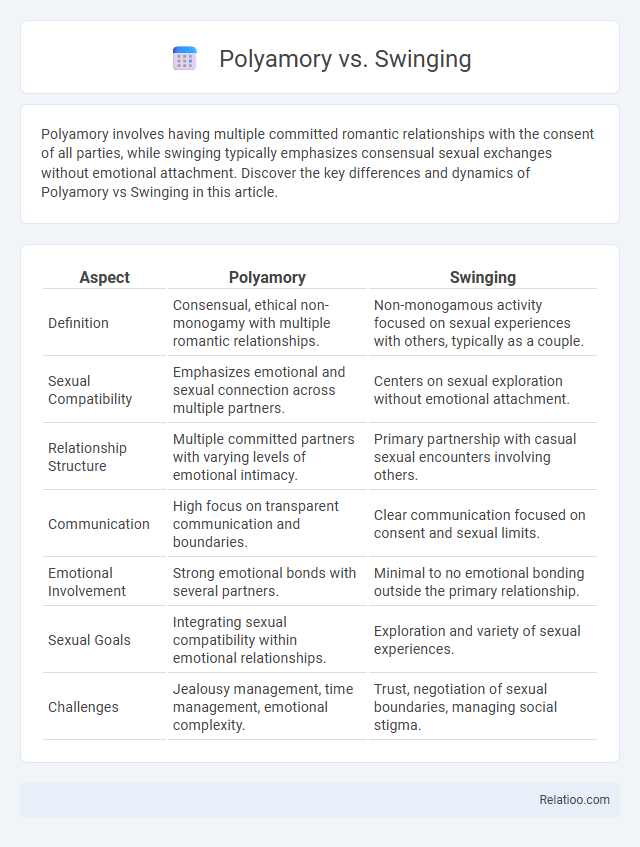Polyamory involves having multiple committed romantic relationships with the consent of all parties, while swinging typically emphasizes consensual sexual exchanges without emotional attachment. Discover the key differences and dynamics of Polyamory vs Swinging in this article.
Table of Comparison
| Aspect | Polyamory | Swinging |
|---|---|---|
| Definition | Consensual, ethical non-monogamy with multiple romantic relationships. | Non-monogamous activity focused on sexual experiences with others, typically as a couple. |
| Sexual Compatibility | Emphasizes emotional and sexual connection across multiple partners. | Centers on sexual exploration without emotional attachment. |
| Relationship Structure | Multiple committed partners with varying levels of emotional intimacy. | Primary partnership with casual sexual encounters involving others. |
| Communication | High focus on transparent communication and boundaries. | Clear communication focused on consent and sexual limits. |
| Emotional Involvement | Strong emotional bonds with several partners. | Minimal to no emotional bonding outside the primary relationship. |
| Sexual Goals | Integrating sexual compatibility within emotional relationships. | Exploration and variety of sexual experiences. |
| Challenges | Jealousy management, time management, emotional complexity. | Trust, negotiation of sexual boundaries, managing social stigma. |
Understanding Polyamory: Definition and Core Values
Polyamory is defined as the practice of engaging in multiple consensual, emotionally intimate relationships simultaneously, emphasizing honesty, communication, and mutual respect among all partners. Unlike swinging, which often centers on recreational or sexual encounters without deep emotional involvement, polyamory prioritizes building meaningful connections and nurturing long-term bonds. Core values of polyamory include transparency, consent, and the recognition of each partner's autonomy and emotional needs.
What is Swinging? Key Principles and Practices
Swinging involves committed couples engaging in consensual sexual activities with others, typically in social or party settings, emphasizing recreational sex without emotional attachment beyond the primary relationship. Key principles include clear communication, mutual consent, trust, and established boundaries to maintain relationship security. Practices often involve attending swinger clubs, hosting or participating in swap parties, and using online platforms to connect with like-minded partners.
Main Differences Between Polyamory and Swinging
Polyamory involves forming multiple emotional and romantic relationships with the knowledge and consent of all parties, emphasizing long-term commitments and deeper connections. Swinging typically centers around consensual sexual activities with others outside the primary relationship, often without forming emotional bonds. The primary difference lies in polyamory's focus on emotional intimacy and relationship-building, whereas swinging prioritizes sexual variety without necessarily involving romantic attachment.
Relationship Structures: Emotional vs. Physical Focus
Polyamory centers on forming multiple emotionally connected relationships, emphasizing deep bonds and committed partnerships beyond just physical intimacy. Swinging primarily involves consensual sexual activities with others, focusing on physical experiences rather than emotional connections. Your understanding of these relationship structures can help navigate boundaries between emotional commitment in polyamory and the physical focus characteristic of swinging.
Communication Styles in Polyamory and Swinging
Polyamory involves deep emotional connections with multiple partners, requiring ongoing, transparent communication to navigate complex feelings and boundaries effectively. Swinging typically emphasizes sexual experiences with others outside the primary relationship, often relying on negotiated agreements and clear, concise discussions about limits and consent. Your ability to foster open dialogue and active listening is crucial in both lifestyles to maintain trust and mutual respect.
Jealousy and Boundaries: Managing Emotions
Polyamory requires clear communication and established boundaries to manage jealousy by fostering trust and emotional honesty among multiple partners. Swinging typically involves couples engaging in sexual activities with others but emphasizes maintaining a primary relationship, with jealousy often managed through pre-negotiated rules. Effective management of jealousy in both lifestyles depends on mutual consent, respect for boundaries, and continuous emotional check-ins to ensure all parties feel secure and valued.
Pros and Cons of Polyamorous Relationships
Polyamorous relationships offer emotional depth and multiple intimate connections, fostering personal growth and open communication, but they require strong boundaries, time management, and handling complex jealousy dynamics. Compared to swinging, which emphasizes sexual encounters without emotional attachment, polyamory demands deeper commitment and emotional investment. Cons include potential social stigma, challenges in balancing multiple partnerships, and the necessity of transparent communication to maintain trust and harmony.
Advantages and Challenges of Swinging
Swinging offers the advantage of clear boundaries and focused sexual experiences with other couples, fostering enhanced communication and trust within the primary relationship. However, challenges include managing jealousy, navigating social stigmas, and ensuring mutual consent to maintain emotional stability. Unlike polyamory, which emphasizes emotional connections with multiple partners, swinging primarily revolves around consensual sexual encounters, often without seeking deeper romantic involvement.
Social Perceptions and Common Misconceptions
Polyamory often faces social misconceptions as being synonymous with promiscuity, while swinging is frequently viewed strictly as a recreational sexual activity without emotional involvement. Polyamory emphasizes multiple emotional relationships, challenging traditional monogamous norms, whereas swinging centers around consensual partner swapping primarily for sexual experiences. Understanding these distinctions helps clarify common misunderstandings, allowing you to navigate and communicate your relationship style more effectively within social contexts.
Choosing What’s Right: Factors to Consider
Choosing between polyamory, swinging, and monogamy requires evaluating personal values, emotional needs, and communication styles. Polyamory emphasizes multiple meaningful relationships with emotional depth, while swinging focuses on consensual partner swapping, often emphasizing sexual exploration without deep emotional involvement. Assessing relationship goals, boundaries, and risk tolerance helps determine the best fit for individual lifestyles and relationship dynamics.

Infographic: Polyamory vs Swinging
 relatioo.com
relatioo.com